The Healthy Skater: Stretching & Warm-Up for Skaters
by Andrea Sobieraj, MS, CSCS
What is happening inside your muscles?
You arrive at the rink and get your skates on. Ready to go? Not quite! Just as you gave your body fuel from your last snack or meal, now is the time when your muscles have to take that energy and utilize it to move muscle cells. Energy is created when we burn fuels (carbohydrates, fats and protiens) inside the muscle cell and create our energy molecule, called ATP (adenosine triphosphate).
Muscle contraction (movement) occurs when we take the energy molecule ATP and use it to move muscle cells at the molecular level (this means inside the muscle cell). One main thing we need to get those fuels broken down and create ATP is oxygen. Oxygen is delivered to your muscles via your blood (oxygen binds to hemoglobin inside a red blood cell). Once you start exercising, blood flow to your organs (e.g., stomach, kidneys) decreases, and a higher amount is sent to your muscles being used as well as to the skin to temperature regulate.
Why we should warm up
In essence, warming up helps increase the speed of getting oxygen-rich blood flow to the muscles to burn fuels and create ATP. The chemical reactions that occur inside the muscle cell that creates ATP also lead to an increase in internal heat. The internal heat created enhances the ability of the muscle cells to mechanically move.
Pre-exercise warm-up and stretching
Most of us do not have a lot of time after arriving at the rink before we are to be on the ice. I am taking that into consideration here and this warm-up is a minimal suggestion.
As your feet leave your regular shoes, start with an eccentric (lengthening stretch) of your arch on the bench. Pull your forefoot toward you, hold for 30 seconds
and repeat two more times, then do other foot.
Once your skates are on, you are ready to begin an on-ice dynamic warm-up. A dynamic warm-up means moving the body in sport-specific movements for no less than three and up to 10 minutes at a light to moderate pace.
An example I find effective includes:
- Several laps around the rink incorporating big swizzles down one side, crossovers on corner, over-lengthened and over-held time with leg extension in powerful strokes up other side, hugging one leg to chest in a one-foot glide down half the rink, then switching to other leg (hip flexors and glute stretch, as well as turning your brain on to balance).
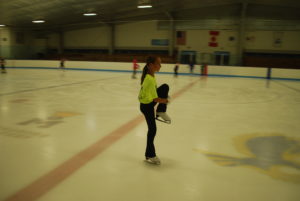
2. Grabbing your blade on one boot to buttocks down half the rink, then switching to other side (quad stretch, and balance turn on), deep squats (dips), extend arms forward as if you are pushing something away (back stretch), hold as long as you can and repeat several times.
3. In any of the above moves, when possible, stretch the arms above head reaching as high as you can, feeling a stretch along your sides (ab stretch, back stretch).
Using these above exercises for several laps gets you prepared to then move into more traditional warm-up of forward and back crossovers and basic large jumps. If you are one of those skaters who always stretches your legs on the side of the rink (as a barre), then this would be the time to do so (but please avoid this when you first get on the ice, as stretching a cold muscle is not helpful, and can even result in injury). If you decide to stretch on the rink side alone or with a coach’s assistance, please make sure to hold each stretch for a minimum of 15 seconds (I recommend 30 seconds). Repeat this stretch three times per position and leg.
Post-exercise stretching
While exercising, your muscles can build up substances from the chemical reactions in the muscle cell. That’s why an active cool down/stretching time is important. This post-exercise movement increases blood flow to help remove substances and get fresh oxygen and fuels to help the muscle recover. If time permits, save five to 10 minutes to do slow, steady skating, such as the suggested dynamic warm-up mentioned above, but at a slower pace.
Once you are off ice, any slow-based stretching will be beneficial. If you are able to do this, hold stretches 15 to 30 seconds and repeat three times per stretch. As a final note, while in recovery, drink water and have some simple carbohydrates (with a small amount of protein if tolerable) to help increase blood flow, replenish fuels and provide nutrients for muscle repair. The more you help your muscles recover, the less pain you should feel from your skate
Andrea Sobieraj teaches exercise physiology at Brown University and conducts metabolic and off-ice strength and conditioning for figure skaters in the Boston area. In her free time, she ice dances and is a member of the competitive theater on-ice team, Imagica of Boston.

 MY COACH ROCKS
MY COACH ROCKS TEAMS IN SYNC
TEAMS IN SYNC EXPRESS YOURSELF
EXPRESS YOURSELF FOCUS ON ARCHIVES
FOCUS ON ARCHIVES COMPETITORS’ CORNER
COMPETITORS’ CORNER NEWS & NOTES
NEWS & NOTES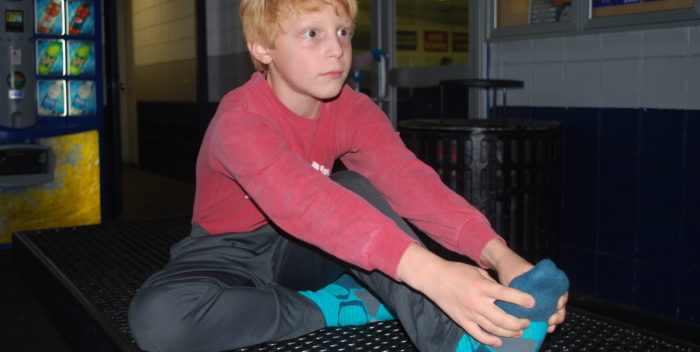
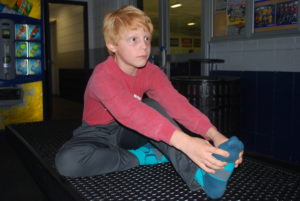
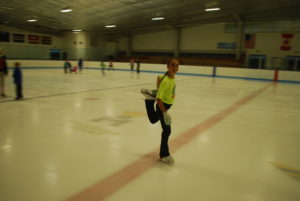
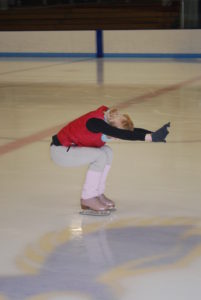
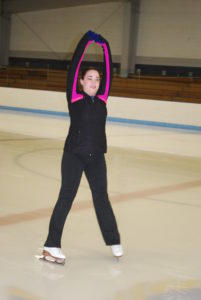







I love this I read it to my daughter that does Jade Blades and solos!